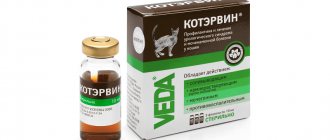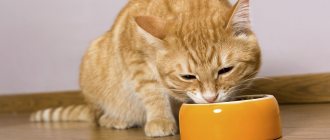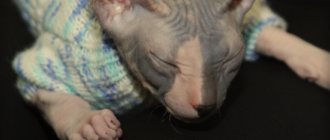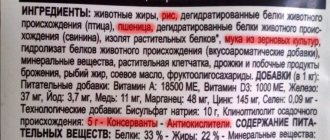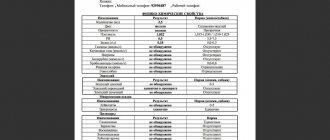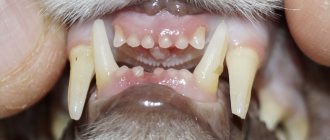Urolithiasis (UCD) is a pathology associated with metabolic disorders. It is often found in domestic cats, is accompanied by severe pain, worsens the quality of life and even reduces its duration. Therefore, if your pet has urolithiasis, you need to take immediate action - even if you suspect it, you should consult a doctor.
According to doctors, along with medications, therapeutic nutrition plays an important role in the treatment and prevention of diseases of the genitourinary system. It allows you to reduce unpleasant symptoms and reduce the amount of insoluble sediment in the urine, due to which the animal experiences severe pain when visiting the toilet.
Let's look at why KSD can develop, how to organize nutrition, and what cat food helps cope with the disease.
Features of ICD in cats
Among all diseases of the genitourinary system, cats most often suffer from renal failure and urolithiasis. If an animal develops urolithiasis, an insoluble sediment begins to be deposited in the urethra, bladder and renal pelvis - uroliths. These are crystals consisting of mineral and organic substances that form calculi - hard particles similar to sand or stones. This process is called urolithiasis. The accumulation and movement of stones in urolithiasis leads to blockage of the urinary tract, causing the cat to experience pain.
Uroliths are divided into:
- oxalates - dense round formations from oxalic acid salts are formed, most often, in urine with a high level of acidity;
- struvites - loose or solid formations of magnesium, ammonium or phosphate nature;
- urates - solid formations with sharp traumatic outgrowths on the surface, formed from uric acid salts;
- cystines - consist of sulfur and cystine and are extremely rare.
The most common type of urolithiasis is the struvite type. Such formations occur in 60% of cases, mainly in cats under six years of age. In second place are oxalates; they accumulate more often in animals older than seven years. Urates and cystines are rare; these types of urolithiasis are treated primarily with medications.
Calcium phosphates
Calcium phosphates are a group of related urolites: whitlockite (Ca3(PO4)2), brucite (CaHP04.2H2O), hydroxyapatite (Ca5(PO4)3OH). These compounds are more often found in mixed stones, in combination with oxalates and struvite. The formation is associated with increased concentrations of calcium and phosphates in the urine. The risk of formation increases at alkaline pH.
Risk factor: hypercalcemia. It may be associated with a number of pathologies, for example, primary hyperparathyroidism. Among dietary factors, hypercalcemia, and, as a consequence, the formation of phosphate uroliths, is provoked by vitamin D hypervitaminosis.
Causes of pathology development and methods of combating
Urolithiasis and other renal pathologies are caused by various reasons:
- improperly organized cat nutrition, excess salt in the diet;
- small quantity of water or its poor quality;
- inflammatory, systemic diseases - cystitis, urethritis and others;
- sedentary lifestyle, high-calorie foods and, as a result, obesity;
- genetic predisposition - Persian, Siamese and Russian blue cats suffer from urinary tract pathologies more often than others, which is due to the peculiarities of crossing during breeding.
In cats, the risk of developing urolithiasis is higher than in cats, since their urethral lumen is narrower. Sterilized animals are also at risk, as they are less active and quickly gain excess weight, which leads to obesity.
Therapeutic nutrition, plenty of clean water, active movement and weight control are decisive factors in the fight against urolithiasis. Cat food selected for the specific situation helps reduce the amount of insoluble sediment in the urine and, together with plenty of drinking, removes stones from the animal’s body. It is important that the pet does not overcool, otherwise inflammatory processes may develop in the genitourinary system.
Diet therapy for urolithiasis
Anna Lineva, veterinary nutritionist, resident ECVCN Department of Nutrition, Veterinary Faculty LMU (Ludwig Maximillian University, Munich)
Introduction
Urolithiasis in cats and dogs is a disease of the lower urinary tract, which is accompanied by difficulty urinating, hematuria and other symptoms. Different species of animals are predisposed to uroliths of different chemical composition under the influence of different, often species-specific factors. These may be: metabolic factors, volume and frequency of urination, qualitative and quantitative composition of substances excreted in the urine, concentration and pH of urine, promoters and inhibitors of crystals, matrix formation, body temperature, urinary tract infections and more.
Breed, age and gender also have an impact on the formation of different types of uroliths.
The distribution of stone types also varied over the years. This can be explained by changes in factors influencing the formation of stones, and, mainly, by changes in typical diets.
The composition of the diet, primarily mineral, can have a significant influence on stone formation in dogs and cats, and for some types of stones is a major predisposing factor to crystal formation. At the same time, the properties of the diet can be used for preventive and therapeutic purposes, having a direct or indirect effect on the formation of stones.
Some types of stones and crystals can be dissolved through diet, for some there are only preventive measures, but for most common types of uroliths, diet plays an important role among therapeutic measures.
The role of pH in the formation of crystals in urolithiasis
The acid-base environment is one of the most important factors in the formation of crystals and stones in urolithiasis; each type of stone has its own optimal pH level at which they form (Table 1).
Urine pH is influenced by various factors, of which the cation-anion composition of the diet plays an important role. By changing the proportions between cations and anions, you can influence the pH of urine. In addition to this measure, supplements are also available that acidify or alkalize urine.
Other dietary factors that influence stone formation are listed in Table 2.
For other stones (for example, phosphates, xanthines, silicates, etc.), there are dietary measures, although among the causes that cause them, dietary factors have little or no importance.
Table 1. Effect of pH on the formation of different types of crystals in ICD
| Type of stones | Sour: < 6,5 | Neutral: 6,5–7,5 | Alkaline: > 7,5 |
| Struvite | – | + | ++ |
| Calcium oxalates | ++ | + | + |
| Urats | + | + | +/– |
| Cystine stones | + | +/– | – |
Table 2. Factors of formation and growth of crystals of different types
| Type of uroliths | Dietary shaping factors |
| Struvite | High magnesium content High phosphorus content Low water consumption High plant content (↑ pH) |
| Calcium oxalates | High but also low calcium levels High oxalic acid levels High hydroxyproline levels Low magnesium levels Excessive vitamin C Vitamin B6 deficiency Low water intake |
| Urats | High purine content (animal DNA) |
| Cystine stones | High content of sulfur-containing amino acids |
Struvite with urolithiasis
Magnesium ammonium phosphate stones are the most common cause (>90%) of urinary tract obstruction (UTO) in cats. While in dogs these stones are associated with bacterial infection (>60%), in cats they are more likely to be sterile.
The role of bacterial infection in the formation of struvite is significant: in dogs Staphylococcus spp. is more often found, but also Proteus, E. Coli, Streptococcus, Klebsiella, Pseudomonas and Enterobacter. Bacteria that produce urease break down urea into two ammonia ions for use in the process of synthesizing their own protein. Thus, the concentration of ammonium, one of the components of these stones, increases. The increase in cations increases the pH of the urine. Phosphorus ions dissociate in this environment, increasing the concentration of phosphates, which form complexes with ammonium and magnesium (PO43-). When there are enough stone components, struvite begins to form and grow. An important point regarding dietary therapy: the decisive factor in the process of formation of struvite-type uroliths is the pH of the urine, and not the concentration of struvite components. Therapy for struvite in dogs, in addition, must necessarily include antibacterial measures.
Therapy for struvite in cats and dogs
- Specific therapy for UTI infection.
- Elimination of obstructions of the urinary tract.
- Ensure sufficient water supply to dilute urine concentration.
- Removal or dissolution of struvite.
- Timely recognition of relapses - regular monitoring.
Dietary measures. Diet therapy for struvites may be the only necessary measure for their successful dissolution. If there is no obstruction of the urinary tract and no contraindications for urine acidification, the diet is prescribed until the stones are completely dissolved + another 4 weeks so that small crystals invisible on ultrasound or radiographic examination are completely dissolved. Otherwise, they can serve as a ready-made matrix for the repeated formation of struvite. With a bacterial complication, the diet can last on average 3 months (cases from 2 weeks to 7 months have been recorded).
Properties of the diet for dissolving struvite in animals:
- moderate level (according to needs) of protein (for dogs);
- low but sufficient phosphorus levels;
- low but sufficient magnesium levels;
- acidifying cation-anion balance.
Acidification is possible through the use of additives containing an increased amount of anions: for example, methionine, calcium sulfate. Manufacturers of commercial diets provide an estimated target pH based on the cation and anion content of the feed. In some cases, the stated target pH is also confirmed by clinical observations, but individual deviations are possible, so the pH must be monitored and diet therapy changed if necessary. In addition, increasing water intake can help dissolve stones. For this purpose, sodium levels are increased in diets prescribed for urolithiasis in cats and dogs, which stimulates water consumption. Using wet food also helps increase water intake. The most important parameter for this diet is achieving the target pH.
Some food companies produce diets to prevent both struvite and oxalate. This is due to the fact that a diet aimed at only one type of stone can create conditions for the formation of others. The search for compromises in formulations has led to the creation of acidifying diets, but additionally low in calcium and oxalic acid, as well as other factors in the endogenous formation of oxalates (see below). In other cases, there is an option for dissolving struvite and a second preventive food aimed at preventing most common uroliths. The observed variation in sodium content is due to the fact that in one case a decision was made to increase it in order to dilute the concentration of urine, and in others, on the contrary, to reduce it, since increased excretion of sodium contributes to increased excretion of calcium in the urine, which may become an additional factor for the formation struvite.
Such a variety of solutions allows in practice to individually select the most suitable option: only dissolution of struvite or dissolution + simultaneous prevention of oxalates.
Some companies offer a choice of foods that dissolve struvite for different ages or sizes of dogs, as well as foods with a combined effect: struvite + overweight, for example.
Wet food for dissolving struvite in case of urolithiasis more effectively stimulates water intake, which is often important especially for cats if the cat drinks little water. This is also an important factor for dogs. In addition, the palatability of wet food is higher for both dogs and many cats.
Long-term acidification is not indicated, as it can create conditions for metabolic disorders and aggravate the course of certain diseases (for example, kidney disease). Therefore, after successful dissolution of struvite, a preventive diet without a strong acidifying effect is recommended. This diet can usually be used long-term.
Table 3. Examples of diets (dry food) for dissolving struvite in dogs (amounts per 100 g of dry matter at a moisture content of 10%)
| Diet | Acidification | Crude protein, % | Phosphorus, % | Magnesium,% | Sodium,% |
| Farmina Vet Life Struvite | Calcium sulfate | 21,60 | 0,56 | 0,07 | 0,28 |
| Happy Dog Struvit | Methionine | 20,56 | 0,56 | 0,06 | 0,78 |
| Hill's c/d* | S+OXSHIELD | 21,00 | 0,53 | 0,1 | 0,25 |
| Purina UR* | Calcium sulfate | 24,00 | 0,67 | 0,08 | 0,22 |
| Royal Canin Urinary S/O* | Methionine, calcium sulfate | 20,00 | 0,56 | 0,04 | 1,22 |
* The product was created for the simultaneous prevention of struvite and oxalates
Table 4. Examples of diets (dry food) for dissolving struvite in cats (amounts per 100 g of dry matter at 10% humidity)
| Diet | Acidification | Crude protein, % | Phosphorus, % | Magnesium,% | Sodium,% |
| Farmina Vet Life Struvite | Calcium sulfate | 37,78 | 0,67 | 0,07 | 0,29 |
| Happy Cat Struvit | Methionine | 33,33 | 0,61 | 0,06 | 0,67 |
| Hill's s/d | Calcium sulfate, methionine | 33,60 | 0,78 | 0,07 | 0,40 |
| Purina UR* | Phosphoric acid | 38,89 | 0,89 | 0,09 | 1,33 |
| Royal Canin S/O* | Methionine, calcium sulfate | 38,33 | 1,00 | 0,05 | 1,44 |
* The product was created for the simultaneous prevention of struvite and oxalates
Oxalates for urolithiasis in dogs and cats
With these stones, an understanding of the nature of their formation is necessary. Crystallization of calcium oxalates during urolithiasis in dogs and cats occurs provided there is a sufficient amount of the components that form them, in low dependence on urine pH. In an acidic environment, this process occurs faster, because calcium, being one of the buffering substances in the body, is excreted into the urine in larger quantities compensatory, to neutralize it. Large amounts of calcium create conditions for crystallization.
In general, the formation of oxalates is a multifactorial process, which, in addition to dietary factors (high calcium and oxalic acid, urine acidification, low magnesium levels), is also associated with others, for example, metabolic processes.
Paradoxically, too low levels of calcium in the diet can also promote the formation of oxalates. Calcium forms an insoluble complex with oxalic acid in the intestine, which is not absorbed and is excreted from the intestine. When calcium levels are low, oxalic acid is absorbed in greater quantities, increasing its concentration in urine.
Magnesium plays an important role in binding oxalic acid, which also occurs in urine. Thus, oxalic acid does not bind to calcium and does not form calcium oxalate crystals. Low magnesium levels increase the amount of oxalic acid available to form complexes with calcium.
Oxalic acid is an organic acid found in some dog and cat food ingredients, such as rhubarb, spinach and other green leafy vegetables, wheat bran, and beets. But oxalic acid also has an endogenous origin (synthesis in the liver): it is the end product of protein and carbohydrate metabolism. A high intake of hydroxyproline and/or glycine will enhance endogenous oxalate formation. Hydroxyproline is contained in increased quantities in connective tissue elements, therefore, such components of the diet (tendons, including those in treats, entrails, etc.) are contraindicated for animals with oxalate-type uroliths.
With a high content of vitamin C in the diet, increased endogenous synthesis of oxalic acid will also occur. Low pyridoxine content also increases its synthesis.
Oxalate therapy in veterinary medicine
- Relieve obstruction, if present.
- Treatment of potential risk factors (hyperparathyroidism, hyperadrenocorticism).
- Stone Removal - Oxalates cannot be dissolved.
Dietary measures. Ensure adequate water intake to dilute urine. As mentioned above, the use of sodium in the diet for oxalate prevention is controversial. On the one hand, high sodium levels increase calcium excretion in the urine. On the other hand, an increase in sodium increases water intake and the concentration of calcium in the urine decreases. With a controlled increase in sodium under control of urine composition, optimal conditions can be achieved to prevent the formation of stones.
Basic dietary measures are aimed at:
- increasing pH to neutral/moderately alkaline;
- reducing the calcium content to the level of meeting the needs for it and ensuring the binding of oxalic acid in the intestine;
- exclusion of components with a high content of oxalic acid;
- exclusion of components containing a large number of oxalic acid precursors (hydroxyproline, glycine);
- eliminating supplements containing vitamin C;
- ensuring sufficient amounts of vitamin B6.
Urates and xanthines in domestic animals
Urates are a heterogeneous group of stones formed in domestic animals as a result of purine metabolism. They are formed as a result of a genetic defect in some dog breeds (Dalmatian, English bulldog), as well as as a result of serious diseases leading to disruption of normal purine metabolism (portosystemic shunt, late stages of liver disease). In cats, urates are also observed, but the reasons for their formation have not yet been sufficiently studied. Portosystemic shunt can also cause urate in cats.
Purines can be of endogenous origin or dietary origin. Both sources form a specific pool that is subject to metabolic transformation for use or excretion from the body. In several steps, purines are converted in the liver to hypoxanthines, then to xanthines and then to uric acid. The last two processes require the presence of the enzyme xanthine oxidase. Xanthines and uric acid are poorly soluble, which can lead to their accumulation in the urine and the formation of stones. Normally, uric acid is converted by the enzyme uricase into allantoin, which is already highly soluble in water, and is excreted in the urine. The genetic breed defect is thought to be an insufficient conversion of uric acid to allantoin, possibly due to the affected breeds being less permeable to uric acid in their liver cell membranes or due to a deficiency of uricase. In addition, normally up to 98–100% of uric acid is reabsorbed in the proximal tubules and metabolized in the liver. In Dalmatians, this reabsorption is impaired, which increases the concentration of uric acid. Figure 1 shows a diagram of purine metabolism (from Roudebush, P., Hand, MS, Thatcher, CD, Remillard, RL, & Lewis, LD (2000). Small animal clinical nutrition). Xanthines are also formed due to genetic defects (absence or low activity of xanthine oxidase) in some breeds: Cavalier King Charles Spaniel, Dachshund, Dalmatian, English Bulldog, Miniature Schnauzer, Poodle and Shih Tzu. The breed distribution has geographical differences. Secondary formation of xanthines is possible during therapy with allopurinol, the action of which is aimed at suppressing xanthine oxidase.
Figure 1. Scheme of purine metabolism
Therapy and prevention of urates and xanthines in animals
- Low purine diet.
- Xanthine oxidase inhibitor.
- Alkaline urine pH.
- Increased urine volume.
- If stones are present without symptoms of obstruction, they do not need to be removed—ammonium urates can be dissolved through dietary measures.
- Large stones that cause obstruction require removal.
- Exclusion of dogs with defects from breeding.
Diet therapy. The administration of allopurinol is effective in converting xanthines into uric acid and thus preventing this type of stones. But with a high intake of purines in the diet, xanthines will form and accumulate without the action of xanthine oxidase. Therefore, allopurinol therapy must be accompanied by a low-purine diet.
Cystine stones in animals
This type of stones in animals also forms in an acidic environment due to a defect in the gene encoding the transport system for amino acids in the kidneys (Irish Terrier, Basset Hound, Dachshund, Newfoundland, English Bulldog). Cystine is formed from methionine with an intermediate metabolite cysteine. When cystine reabsorption is defective, it accumulates in the urine and, being less soluble than cysteine, forms stones.
Therapy for cystine stones
- Reducing methionine in the diet.
- Stimulation of diuresis.
- Alkalinization of urine and increased solubility of cystine.
- Drug therapy with the formation of highly soluble disulfides with cysteine (tiopronin, D-penicillamine).
- Reduction of cystine to cysteine (ascorbic acid).
- Reduced sodium (stimulates cystine filtration).
Diet therapy for cats and dogs . Methionine is found in large quantities in almost all animal components. Diet therapy for cats and dogs in this case involves the exclusion of treats with such components, as well as table scraps, food from other animals in the house, bones “to strengthen teeth,” etc. The use of potassium citrate as an alkalizing therapy is well justified in humane medicine . Potassium citrate is preferred to sodium bicarbonate because sodium can stimulate the excretion of cystine. The use of ascorbic acid has some risk, since it should only be prescribed with simultaneous alkalization therapy. In addition, it is one of the possible precursors of oxalic acid.
All of the above stones have a number of common properties that can be influenced by the same dietary measures. Therefore, creating a diet for mixed stone types is also possible.
For cats, there are additional recommendations for any type of stones:
- the use of wet food is preferable to increase moisture intake;
- regular cleaning of the tray;
- stimulation of physical activity;
- exclusion of ad libitum feeding (risk of developing excess weight);
- eliminating stress factors.
Other common types of stones are not discussed in this article, since there are currently no specific dietary measures for them.
Table 5. Examples of diets (dry food) for the prevention of various stones in dogs
| Diet | Options |
| Farmina VetLife Oxalate | Prevention of oxalate, urate, xanthine and cystine stones Potassium citrate (alkalinization) Low mineral content Low nucleic acid content |
| Happy Dog P-Urinary | Prevention of oxalate, urate, xanthine and cystine stones Low protein levels Low purine content Neutral urine pH (target calculation parameter) |
| Hill's u/d | Controlled protein levels Low sodium and calcium Prevention of all non-struvite stones Supports kidney function |
| Royal Canin Urinary U/C | Low purine content (urate prevention) Low protein and methionine content (cystine stone prevention) |
Table 6. Examples of diets (dry food) for the prevention of various stones in cats
| Diet | Options |
| Farmina VetLife Neutered male/female | Low phosphorus and magnesium content (prevention of struvite) Calcium sulfate (urine pH) - prevention of stones formed in an acidic environment |
| Hill's URINARY care c/d or Metabolic + Urinary | Dissolution and prevention of struvite Prevention of oxalate Reduction of symptoms of FLUTD* |
| Royal Canin S/O, or Neutered Female/Male | Prevention of struvite and oxalate Reduction of urine concentration |
*FLUTD — feline low urinary tract disease (diseases of the lower urinary tract)
Conclusion
Diet therapy for urolithiasis in cats and dogs has some differences due to the different course of the disease and different factors in animals. Dogs often have a bacterial complication, while cats have a multifactorial lower urinary tract disease syndrome. Because a diet targeting only one type of stone may promote the formation of others, many food manufacturers offer a combination approach to the problem. The currently available range allows you to choose the best option for each case, even if the type of stones is mixed or there are primary diseases leading to the formation of uroliths.
Owners often tend to attach great importance to diet and explain the occurrence and course of the disease only by diet parameters. Diet is not always the main factor for the formation of stones, and all factors must be assessed comprehensively and individually in each case. An educational conversation with the owner should be aimed at their understanding of the versatile nature of the disease and the necessary components of monitoring during and after treatment, as well as the necessary preventive measures.
SVM No. 2/2020
Full-time courses in veterinary nutrition
Rate material
Like Like Congratulations Sympathy Outrageous Funny Thoughtful No words
8
Tags
Diet therapy Diet therapy for urolithiasis Cat Xanthines ICD Urolithiasis Oxalates Dogs Struvite Urates Urolithiasis Cystine stones
Rules for feeding cats with ICD
Therapeutic nutrition can be organized in two ways: transfer the animal to dietary natural food or give it special food for cats. In any case, if you suspect urolithiasis, you should immediately visit a veterinarian. He will prescribe tests, since the type of stones can only be determined in the laboratory. The composition of uroliths determines what can be given to a cat and what cannot.
If it is determined that the type of stones in urolithiasis is the struvite type, you need to create a diet so that the natural mixture or cat food acidifies the urine. Then it will neutralize alkaline uroliths. It is important to reduce the caloric intake of the diet, since struvite urolithiasis often provokes obesity. When feeding your cat natural food, you should give preference to boiled meat and fish, egg whites, and liver.
If the stones are acidic (calcium oxalates), the cat needs an alkalizing diet. It should contain less calcium, so dairy and offal products are excluded from the diet. Vegetables, boiled meat, rolled oats, and rice are healthy.
For urolithiasis of all types, nutrition is selected individually. Veterinarians recommend feeding cats five to six times a day, in small portions, and forming the basis of a natural diet of lean meat and fish, meat broths, boiled vegetables - carrots, cauliflower, broccoli, potatoes, beets.
If you have urolithiasis or other kidney diseases, you should not give your animal:
- sausages, lard, smoked meats;
- offal (except liver in some cases) and bone marrow;
- cream and milk with a fat content of more than 1.5%;
- pasta. bakery products;
- eggs (yolk);
- legumes, peas and mushrooms;
- spicy and salty.
Diagnostics
- Vivid clinical signs. The cat cannot pee normally or does not pee at all.
- Palpation of the bladder. Overcrowded, with a thickened wall, sometimes it is possible to feel one or more stones.
- Urine tests. Sand in the urine, signs of inflammation - blood and leukocytes.
- X-ray, ultrasound. Detection of large stones in the kidneys and bladder.
When making a diagnosis, anamnestic data on the cat’s behavior, palpation of the bladder, clinical signs of hematuria, pain and laboratory tests of urine, urine sediment, and the presence of microflora are taken into account.
Diagnosis of urolithiasis in cats is carried out based on pronounced clinical signs. In cats, when a stone forms in the kidney or bladder, the diagnosis is confirmed by ultrasound and x-ray. During the examination, it is necessary to conduct laboratory tests of urine and ultrasound, since in some cases other diseases (tumors, inflammatory edema, cystitis) may manifest themselves in a similar way.
What foods are suitable for cats with urinary tract diseases?
Due to strict restrictions in diet composition, natural nutrition is difficult to organize. The solution is specially developed ready-made diets - wet canned food (pouches) or dry food for cats. They must be of high quality - premium or, preferably, super-premium. Budget cat food does not contain the best protein, a lot of salt, and chemical additives. They worsen the animal’s condition and can lead to dangerous disorders of the gastrointestinal tract and kidneys.
Therapeutic food for cats with pathologies of the genitourinary system is selected taking into account the type of stones. If it is oxalates, natural food and/or wet canned food can be given. For struvite-type urolithiasis, you can choose special dry cat food.
Rules for choosing diets:
- There should be a note on cat food that it is suitable for animals with diseases of the genitourinary system and what types of uroliths it affects;
- It is advisable that cat food contain vitamin A and tocopherol - they improve the condition of urolithiasis;
- the composition should contain a minimum of calcium, phosphorus and vitamin C - ascorbic acid provokes the accumulation of uroliths;
- The percentage of protein in cat food should be reduced - because of this, animals may be reluctant to eat it, and you need to gradually accustom your pet to the new diet.
Choosing the right food
Foods marked Urinary are primarily aimed at destroying the formed struvite or oxalate stones.
It is often difficult to independently understand the choice of medicinal food. There are many types of medicinal food, but they can sometimes worsen the condition of a sick cat.
Therefore, you should not take risks; it is better to entrust an important matter to a specialist. Based on the diagnosis, the doctor will prescribe the appropriate type of nutrition.
The result of a properly selected diet is an improvement in the pet’s condition, increased activity, and good appetite.
So, dry food or canned food?
The choice of food depends on the type of stones. If you have oxalates, you can’t feed him dry food, only canned food. If struvite is present, you can give dry food containing special additives, as well as canned food.
Economy
This series of food is not intended for feeding cats with ICD, as it does not have a balanced composition.
Moreover, such foods as Whiskas and Kitikat can harm the health of the animal.
Premium
Allowed for cats suffering from kidney stones.
Super premium
Royal Canin Urinary
The most suitable type of feeding for pets with ICD.
This series includes:
- Royal Canin Urinary S/O LP 34;
- Hill's Prescription Diet Metabolic;
- Eukanuba Urinary Oxalate (to dissolve oxalates);
- Eukanuba Urinary Struvate (to dissolve struvite);
- Purina UR;
- Purina NF.
Each food has contraindications, some are prohibited for cats with high blood pressure. Therefore, you should consult your veterinarian before using the food.
Treatment of urolithiasis by veterinarians
Algorithm | treatment regimen. Painkillers, antispasmodics, antibiotics (dosage).
Veterinarian treatment regimen for urticaria, injections, tablets, dosage of medications: no-spa, papaverine, baralgin, prazosin, terazosin, glutargin, glucose, Ringen-Lock solution, Vetavit, nitroxoline, furadonin, endrofloxacin, etamsylate (dicinone), vikasol
Treatment of urolithiasis, dosage of drugs and how to take: stop cystitis, uro-ursi, urotropin, cystokur forte, furinaid, ipakitine, cantaren, kotervin, nephrocat, renal advance, himalaya cyston, urolex, healthy kidneys phytoelite
Nutrition: enemy and ally
Malnutrition in cats is one of the provoking factors for the development of urolithiasis. Therefore, when choosing food, you need to consider the following nuances:
- A number of feeds contain excess amounts of phosphorus, magnesium, and calcium. These elements contribute to the formation of crystals in urine.
- The food has a significant effect on the acidity of urine (pH). The cat’s body is “tuned” to digest animal food, which makes the urine slightly acidic, and therefore prevents the formation of stones. In such an environment, crystals dissolve. If the diet is dominated by products of plant origin, which is often found in cheap brands, the pH of the urine shifts towards slightly alkaline. And this contributes to the formation of struvite - one of the most common types of stones.
The likelihood of developing the disease increases if the cat drinks little. In this case, the urine becomes too concentrated and stones form faster.
Prevention
The goal of any prevention is to prevent the disease and eliminate it.
If we have urolithiasis in our sights, then preventive measures include:
- drinking plenty of purified water (this increases daily diuresis);
- maintaining the animal at the correct weight;
- selection of diet depending on the type of stones;
- establishing stable functioning of the gastrointestinal tract, eliminating constipation;
- maintaining optimal room temperature.
